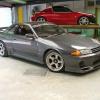Can You Help Me Identify This Plug? Wiring R32 Rb20Det
Announcements
-
Similar Content
-
Latest Posts
-
I also think it comes down to the dollars spent for quality items, there's some cheapie versions out there, which look fine, but, there are versions of much higher quality out there, but, you obviously pay more for the quality of materials used and quality control When I first got work done by Advan Performance on my old R33 the silicone joiners were cheapies and actually blew out on a joiner heading to the plenum, when I then took it to Unigroup they said that the silicone hoses they used and were junk, Unigroup replaced every hose on the engine with much higher quality items and from then I never had a issue with any hose Additional cost and quality gets you quality silicone base materials and quality reinforcement fabric stuff As for OEM rubber hoses, again, quality materials and strict quality control will give you quality hoses, but only to OEM spec, I believe using quality silicone replacements is a upgrade I saying this I have only dealt with vehicles I own and play with
-
By pacman_1219 · Posted
Not gonna lie my sense of smell isn't the best. But it does look more grey to me. It doesn't smell like oil, friend says it smells like fuel. -
That's it. Too rich for me. I'm out. If it does start to sell in pieces, I'll probably register an interest in the diff & axles, gearbox & tailshaft, and maybe the brakes.
-
I tried my best, well I see how it is though... It's time to be ruthless! I'll up my bid with a JVC sub and an amp to run it, 8 stainless steel drink coasters with a rubber backing, and a photo of Tom Cruise. Oh, I can increase the cash portion by 20 cents if that helps.
-
Or if it's grey, is it watery? Does it do it after you've been for like an hour long drive it will still do it, or just near the start of the trip? As GTS said, does it seem like oil (blue), water (white/grey) or fuel (black)? Sometimes the colour can be hard to see clearly too for what it is, as GTS says, what's it smell like?
-





Recommended Posts
Create an account or sign in to comment
You need to be a member in order to leave a comment
Create an account
Sign up for a new account in our community. It's easy!
Register a new accountSign in
Already have an account? Sign in here.
Sign In Now